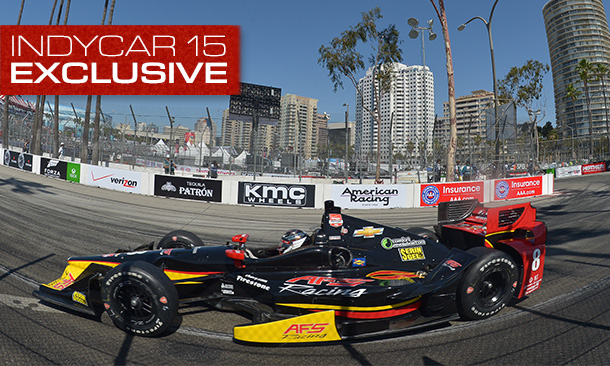Drivers chime in on where best to pass on the Streets of Long Beach
APR 19, 2015
LONG BEACH, California – It’s 1.968 miles of narrow city streets that make up the race course in the 41st Toyota Grand Prix of Long Beach including curbs, a fountain or two and 11 turns. It’s a very tight race course with some long straightaways where the Verizon IndyCar Series race cars get up to 200 miles per hour before hitting the brakes and negotiating a turn with limited passing opportunities.
What makes the Toyota Grand Prix of Long Beach so unique is the challenge of the race course. On a track where it is difficult to pass, how do these drivers pass during the high-speed race?
“Oh, you can always pass,” said Stefano Coletti of KVSH Racing. “People told me you can’t pass at St. Pete and I had 20 overtakings. We had problems in the race and had to start in the back every time and I would pass cars on the restarts and get back in the top 10. You just need to figure out the best spot for you and where you feel comfortable with the car.”
Coletti’s teammate believes the push-to-pass allows drivers to get a run in an attempt to pass.
“You get a good run on the last corner and also on the backstraight you can make something happen,” said three-time Long Beach winner Sebastien Bourdais. “You have to know how to be patient, as well. Patience is a virtue here. If you try to make things happen a little too quick you will only let the others benefit from the chaos you create. Usually, the last part of the race is crazy and you need to be a contender at the end to have a chance.”
Simon Pagenaud of Team Penske believes he has all the ingredients on the team to add his name to the impressive list of drivers that have won on the streets of Long Beach.
“This track suits me well and I’ve had great success in the past,” Pagenaud said. “You have to time your passes. Timing is about everything and timing in the hairpin is a big thing for passing in Turn 1. That’s the big place where you can make a move.”
James Hinchcliffe is competitive on this course and has some great memories of this track. He wants to make some new ones on Sunday.
“I think this car is really well-suited for this track,” Hinchcliffe said. “The straights are long enough we are stretching our legs a bit and it actually has some pretty quick corners for a street course. Turn 1 is pretty quick; Turn 6 and Turn 9 are quick. It’s really technical. That whole 9, 10, 11 section is tricky and that 1, 2, 3 section around the fountain is tricky. I think this car is well suited for this track.”
Graham Rahal competed in this race in 2007 and 2008 in Champ Car and since 2009 in IndyCar and understands this race course as well as any driver in the field. He starts eighth on Sunday and will look for his place to pass.
“This race is always long and demanding,” Rahal said. “It gives you more opportunity in Turns 1 and Turn 6 to stick your nose in places to get ahead of another driver. You have to race smart. I believe we will be very strong here.
“You pass in Turn 1 – that’s an easy place. Turn 6 is a good opportunity because it’s hard to get off Turn 5 when the tires get old. The back straightaway has always been one of my stronger points. And you pass by putting in good laps when others pit with good in-laps and out-laps. You can make up some time there and get by some people.”
Even on the tight and narrow street course a savvy driver can find plenty of passing opportunities at Long Beach.
“Last year I started last and worked my way up to fourth and passed a ton of people,” Rahal said. “Restarts are a way to take advantage of the opportunities. Tire degradation has played a role and when that happens a driver can struggle. I don’t think it’s that tough any more – you can make a move if you need to.”
















